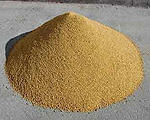



OUTLOOK: Ethanol, Animals and Animal Feed
By Amanda Barth, University of Illinois College of Agricultural, Consumer and Environmental Sciences - The growth of ethanol production would seem to have positive benefits for cattle feeders, and perhaps the dairy industry, said a Purdue University Extension marketing specialist, but the outlook for Hogs and Poultry is not so clear.
"For hogs and poultry, the question is whether the increased price of corn will be offset by added value in the feed product that is returned," said Chris Hurt. "If not, this could mean some restructuring of the location of the U.S. and world animal industries.
"This appears to be particularly true for the eastern Corn Belt and the southeastern United States where hog, poultry and dairy are more dominant."
Hurt's comments came as he reviewed what he termed the "ethanol revolution." He said that while the future has many uncertainties, it is clear that a sufficient number of ethanol plants are currently being built already to call this a revolution that will change the nature of corn demand and corn price relationships.
"While the western Corn Belt continues to build the most new facilities, the Renewable Fuels Association currently lists nine new facilities east of the Mississippi River under construction or expansion," said Hurt. "These include one in Wisconsin, two in Illinois, three in Indiana, and three in Michigan.
"In addition, these states plus Ohio have a number of additional plants that have been announced, but are not yet under construction."
In the animal industries of the eastern Corn Belt and the southeastern United States, the ethanol revolution has raised concerns. In particular, how much will corn prices rise as a result of these large new corn demands, and can animal industries get enough value back from the feed product to offset the potentially higher corn prices?
"Those answers are not easy to derive at this point, but some light can be shed on some of the factors that will be important," he noted. "First, the new corn demand will compete with current uses for corn, and/or corn supply must increase substantially through greater production, which probably means many more acres of corn and fewer soybean acres.
"The new demand could be met from the supply side. As an example, a shift to 60 percent corn acreage and 40 percent soybean acreage in Indiana could meet the current feeding demands, current corn processing demands, and the new growth in demand for ethanol expected by 2008. However, this also has major implications for the soybean sector."
Hurt added that there are interesting dynamics on the corn demand side as well. For the 2005/06 marketing year, U.S. corn consumption is expected to be 55 percent fed in the United States and 17 percent exported. The largest portion of exports is destined for feeding animals as well. The new corn demand for ethanol may compete heavily with animal feeding in the United States and in foreign countries.
"The highest value use of the distillers dried grains (DDG's from dry mills) is in cattle feeding and dairy rations where it primarily substitutes for soybean meal," Hurt explained. "The value in hog and poultry ration is much lower where it substitutes more for corn.
"As an example with current corn and soybean meal prices, DDG's are worth about $170 per short ton in beef and dairy rations but only $84 per short ton in poultry and hog rations. The production of DDG's will be so large that supplies will most likely force DDG prices down to their lowest value, which means they will be similar to, or just above, the value of corn."
Cattle feeders in particular may be able to purchase a low-priced product that has considerably more value in the ration that the costs.
"But the dilemma for the eastern Corn Belt is the low number of cattle on feed," he said. "Currently, only about 8 percent of the U.S. cattle on-feed are in a region that is roughly east of the Mississippi River--including Arkansas and Louisiana. In contrast, 38 percent of the market hogs, 47 percent of the dairy cows, 53 percent of the turkeys, 59 percent of the layers, and 80 percent of the U.S. broilers are in this region."
In contrast to the western Corn Belt, which has been able to move much of its DDG's into cattle on-feed, the eastern Corn Belt will have to move that product into hog, poultry, and dairy rations and/or export large amounts.
"In Indiana, for example, in-state usage of DDG production may be about 40 percent by 2008, but the rest will have to be moved to other regions or exported," said Hurt. "Problems with DDG's in rations of hogs, poultry, and dairy include high phosphorus levels, the impact on fat deposition in milk and meat, as well as concerns about concentrations of mycotoxins. Much more research is needed to answer these and other concerns.
"While there remain many uncertainties, it is clear that the impact of corn ethanol is a 'big event' that could influence animal industries, perhaps for years to come."
Source: ACES, University of Illinois - February 2006








